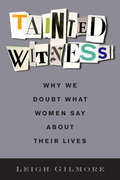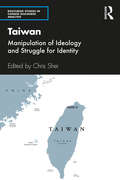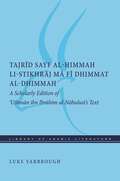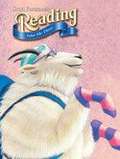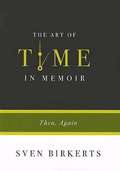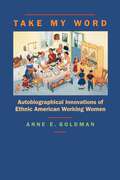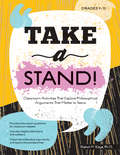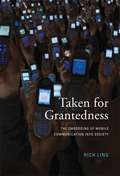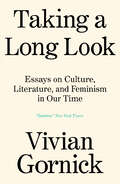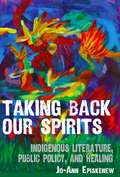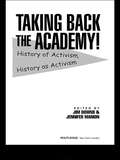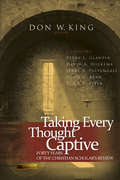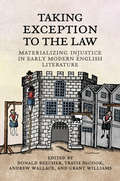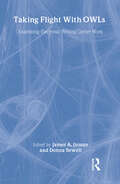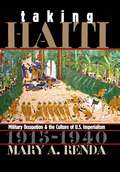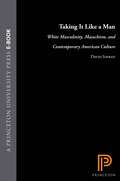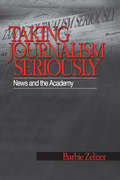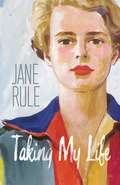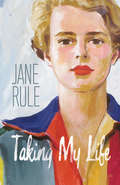- Table View
- List View
Tainted Witness: Why We Doubt What Women Say About Their Lives (Gender and Culture Series)
by Leigh GilmoreIn 1991, Anita Hill's testimony during Clarence Thomas's Senate confirmation hearing brought the problem of sexual harassment to a public audience. Although widely believed by women, Hill was defamed by conservatives and Thomas was confirmed to the Supreme Court. The tainting of Hill and her testimony is part of a larger social history in which women find themselves caught up in a system that refuses to believe what they say. Hill's experience shows how a tainted witness is not who someone is, but what someone can become. Why are women so often considered unreliable witnesses to their own experiences? How are women discredited in legal courts and in courts of public opinion? Why is women's testimony so often mired in controversies fueled by histories of slavery and colonialism? How do new feminist witnesses enter testimonial networks and disrupt doubt? Tainted Witness examines how gender, race, and doubt stick to women witnesses as their testimony circulates in search of an adequate witness. Judgment falls unequally upon women who bear witness, as well-known conflicts about testimonial authority in the late twentieth and early twenty-first centuries reveal. Women's testimonial accounts demonstrate both the symbolic potency of women's bodies and speech in the public sphere and the relative lack of institutional security and control to which they can lay claim. Each testimonial act follows in the wake of a long and invidious association of race and gender with lying that can be found to this day within legal courts and everyday practices of judgment, defining these locations as willfully unknowing and hostile to complex accounts of harm. Bringing together feminist, literary, and legal frameworks, Leigh Gilmore provides provocative readings of what happens when women's testimony is discredited. She demonstrates how testimony crosses jurisdictions, publics, and the unsteady line between truth and fiction in search of justice.
Taiwan: Manipulation of Ideology and Struggle for Identity (Routledge Studies in Chinese Discourse Analysis)
by Chris SheiTaiwan: Manipulation of Ideology and Struggle for Identity chronicles the turbulent relationship between Taiwan and China. This collection of essays aims to provide a critical analysis of the discourses surrounding the identity of Taiwan, its relationship with China, and global debates about Taiwan’s situation. Each chapter explores a unique aspect of Taiwan’s situation, fundamentally exploring how identity is framed in not only Taiwanese ideology, but in relation to the rest of the world. Focusing on how language is a means to maintaining a discourse of control, Taiwan: Manipulation of Ideology and Struggle for Identity delves into how Taiwan is determining its own sense of identity and language in the 21st century.This book targets researchers and students in discourse analysis, Taiwan studies, Chinese studies, and other subjects in social sciences and political science, as well as intellectuals in the public sphere all over the globe who are interested in the Taiwan issue.
Tajrid sayf al-himmah li-stikhraj ma fi dhimmat al-dhimmah: A Scholarly Edition of 'Uthman ibn Ibrahim al-Nabulusi's Text (Library of Arabic Literature #25)
by Luke YarbroughTajrid sayf al-himmah li-stikhraj ma fi dhimmat al-dhimmah is a scholarly, Arabic-only edition of a text by 'Uthman ibn Ibrahim al-Nabulusi, which is also available in English translation from the Library of Arabic Literature as The Sword of Ambition. In this work addressed to the Ayyubid sultan, al-Nabulusi argues against employing Coptic and Jewish officials, leaving no rhetorical stone unturned as he pours his deep knowledge of history, law, and literature into the work.An Arabic edition with English scholarly apparatus.
Take Arms against a Sea of Troubles: The Power of the Reader's Mind over a Universe of Death
by Harold Bloom&“The great poems, plays, novels, stories teach us how to go on living. . . . Your own mistakes, accidents, failures at otherness beat you down. Rise up at dawn and read something that matters as soon as you can.&” So Harold Bloom, the most famous literary critic of his generation, exhorts readers of his last book; one that praises the sustaining power of poetry. "Passionate. . . . Perhaps Bloom&’s most personal work, this is a fitting last testament to one of America&’s leading twentieth-century literary minds."—Publishers Weekly This dazzling celebration of the power of poetry to sublimate death—completed weeks before Harold Bloom died—shows how literature renews life amid what Milton called &“a universe of death.&” Bloom reads as a way of taking arms against the sea of life&’s troubles, taking readers on a grand tour of the poetic voices that have haunted him through a lifetime of reading. &“High literature,&” he writes, &“is a saving lie against time, loss of individuality, premature death.&” In passages of breathtaking intimacy, we see him awake late at night, reciting lines from Dante, Shakespeare, Milton, Montaigne, Blake, Wordsworth, Hart Crane, Jay Wright, and many others. He feels himself &“edged by nothingness,&” uncomprehending, but still sustained by reading. Generous and clear‑eyed, this is among Harold Bloom&’s most ambitious and most moving books.
Take Control of Scrivener 3
by Kirk McElhearnLiterature & Latte’s Scrivener is an innovative app for writing fiction, non-fiction, screenplays, and other long-form texts. This book helps you start writing your masterpiece with Scrivener by showing you how to get the most out of the app’s basic concepts and features.
Take Me Where the Good Times Are
by Robert CormierA resident of a poorhouse brags that some day he'll return to his old town, get a job, and meet up with his old friends. Suddenly he gets a chance to do just that.
Take My Word for It: A Dictionary of English Idioms
by Anatoly LibermanThree centuries of English idioms—their unusual origins and unexpected interpretationsTo pay through the nose. Raining cats and dogs. By hook or by crook. Curry favor. Drink like a fish. Eat crow. We hear such phrases every day, but this book is the first truly all-encompassing etymological guide to both their meanings and origins. Spanning more than three centuries, Take My Word for It is a fascinating, one-of-a-kind window into the surprisingly short history of idioms in English. Widely known for his studies of word origins, Anatoly Liberman explains more than one thousand idioms, both popular and obscure, occurring in both American and British standard English and including many regional expressions.The origins, and even the precise meaning, of most idioms are often obscure and lost in history. Based on a critical analysis of countless conjectures, with exact, in-depth references (rare in the literature on the subject), Take My Word for It provides not only a large corpus of idiomatic phrases but also a vast bibliography. Detailed indexes and a thesaurus make the content accessible at a glance, and Liberman&’s introduction and conclusion add historical dimensions. The result of decades of research by a leading authority, this book is both instructive and absorbing for scholars and general readers, who won&’t find another resource as comparable in scope or based on data even remotely as exhaustive.
Take My Word: Autobiographical Innovations of Ethnic American Working Women
by Anne E. GoldmanIn an innovative critique of traditional approaches to autobiography, Anne E. Goldman convincingly demonstrates that ethnic women can and do speak for themselves, even in the most unlikely contexts. Citing a wide variety of nontraditional texts—including the cookbooks of Nuevo Mexicanas, African American memoirs of midwifery and healing, and Jewish women's histories of the garment industry—Goldman illustrates how American women have asserted their ethnic identities and made their voices heard over and sometimes against the interests of publishers, editors, and readers. While the dominant culture has interpreted works of ethnic literature as representative of a people rather than an individual, the working women of this study insist upon their own agency in narrating rich and complicated self-portraits.
Take Up Thy Bed and Walk: Death, Disability and Cure in Classic Fiction for Girls
by Lois KeithMany Victorian children's books written for girls show a lively, rebellious heroine who, by the end of the story, is tamed and ready to take on the role of submissive young woman. In a number of works, a temporary disability is the crucible which teaches these headstrong girls lessons in patience and humility. Sometimes goodness and will-power are rewarded with a miraculous cure. In other works a dying child serves as a lesson to the living, modeling endurance and faith. Lois Keith explores such themes in children's classics including Little Women, Heidi, The Secret Garden, and Pollyanna. In her final chapter she considers depictions of illness and disability and children's literature of the mid to late 20th century.
Take a Stand!: Classroom Activities That Explore Philosophical Arguments That Matter to Teens
by Sharon KayeTake a Stand! (grades 9–12) helps teens develop critical thinking skills by examining debates on issues directly relevant to their lives (that you won't find in most classroom materials). Each chapter:Covers an important topic relating to electronics, sex, mental health, and relationships.Presents a question for debate, such as "Should kids choose their own religion?" and "Is it possible to love more than one person?"Shows how each issue might arise in an ordinary teen conversation.Presents and explores two or more opposed answers to philosophical debates.Encourages high school students to develop their own positions while learning to appreciate other perspectives.Throughout the book, the chapter contributors—all current or recent teens themselves—highlight key definitions, quote compelling sources, and diagram the central arguments. Each chapter includes discussion questions to guide arguments, as well as helpful sidebars and illustrations to increase comprehension. Perfect for inspiring classroom discussion of topics that matter to today's teens.
Taken for Grantedness
by Rich LingWhy do we feel insulted or exasperated when our friends and family don't answer their mobile phones? If the Internet has allowed us to broaden our social world into a virtual friend-net, the mobile phone is an instrument of a more intimate social sphere. The mobile phone provides a taken-for-granted link to the people to whom we are closest; when we are without it, social and domestic disarray may result. In just a few years, the mobile phone has become central to the functioning of society. In this book, Rich Ling explores the process by which the mobile phone has become embedded in society, comparing it to earlier technologies that changed the character of our social interaction and, along the way, became taken for granted. Ling, drawing on research, interviews, and quantitative material, shows how the mobile phone (and the clock and the automobile before it) can be regarded as a social mediation technology, with a critical mass of users, a supporting ideology, changes in the social ecology, and a web of mutual expectations regarding use. By examining the similarities and synergies among these three technologies, Ling sheds a more general light on how technical systems become embedded in society and how they support social interaction within the closest sphere of friends and family
Taking A Long Look: Essays on Culture, Literature and Feminism in Our Time
by Vivian GornickOne of our most vital and incisive writers on literature, feminism, and knowing one's selfFor nearly fifty years, Vivian Gornick's essays, written with her characteristic clarity of perception and vibrant prose, have explored feminism and writing, literature and culture, politics and personal experience. Drawing writing from the course of her career, Taking a Long Look illuminates one of the driving themes behind Gornick's work: that the painful process of understanding one's self is what binds us to the larger world.In these essays, Gornick explores the lives and literature of Alfred Kazin, Mary McCarthy, Diana Trilling, Philip Roth, Joan Didion, and Herman Melville; the cultural impact of Silent Spring and Uncle Tom's Cabin; and the characters you might only find in a New York barber shop or midtown bus terminal. Even more, Taking a Long Look brings back into print her incendiary essays, first published in the Village Voice, championing the emergence of the women's liberation movement of the 1970s.Alternately crackling with urgency or lucid with insight, the essays in Taking a Long Look demonstrate one of America's most beloved critics at her best.
Taking Back Our Spirits: Indigenous Literature, Public Policy, and Healing
by Jo-Ann EpiskenewFrom the earliest settler policies to deal with the “Indian problem,” to contemporary government-run programs ostensibly designed to help Indigenous people, public policy has played a major role in creating the historical trauma that so greatly impacts the lives of Canada’s Aboriginal peoples. Taking Back Our Spirits traces the link between Canadian public policies, the injuries they have inflicted on Indigenous people, and Indigenous literature’s ability to heal individuals and communities. Episkenew examines contemporary autobiography, fiction, and drama to reveal how these texts respond to and critique public policy, and how literature functions as “medicine” to help cure the colonial contagion.
Taking Back the Academy!: History of Activism, History as Activism
by Jim Downs Jennifer ManionFirst published in 2004. Routledge is an imprint of Taylor & Francis, an informa company.
Taking Every Thought Captive: Forty Years of the Christian Scholar's Review
by Don W. KingTaking Every Thought Captive celebrates forty years of the Christian Scholar's Review by collecting a representation of the best scholarship to appear in its pages from inception in 1970 through 2010.Over its forty years of publication, CSR has had two main objectives: "the integration of Christian faith and learning on both the intra- and inter-disciplinary levels" and "to provide a forum for the discussion of the theoretical issues of Christian higher education."The twenty-four articles gathered in this anniversary collection reflect both of these objectives. As a whole, this collection witnesses to the rigors of the intellectual enterprise found within the pages of CSR and affirms an ongoing commitment to support, enhance, and promote Christian scholarship.Contributors include: Carl F. H. Henry, Arthur F. Holmes, George Marsden, Mary Stewart Van Leeuwen, Stanley Hauerwas, Richard J. Mouw, Mark A. Noll, Dallas Willard, Elizabeth Newman, Roger Lundin, Nancy Ammerman, Nicholas Wolterstorff, and fifteen others.
Taking Exception to the Law: Materializing Injustice in Early Modern English Literature
by Edited by Donald Beecher Travis Decook Andrew Wallace Grant WilliamsTaking Exception to the Law explores how a range of early modern English writings responded to injustices perpetrated by legal procedures, discourses, and institutions. From canonical poems and plays to crime pamphlets and educational treatises, the essays engage with the relevance and wide appeal of legal questions in order to understand how literature operated in the early modern period. Justice in its many forms – legal, poetic, divine, natural, and customary – is examined through insightful and innovative analyses of a number of texts, including The Merchant of Venice, The Faerie Queene, and Paradise Lost. A major contribution to the growing field of law and literature, this collection offers cultural contexts, interpretive insights, and formal implications for the entire field of English Renaissance culture.
Taking Flight With OWLs: Examining Electronic Writing Center Work
by James A. Inman Donna SewellTaking Flight With OWLs examines computer technology use in writing centers. Its purpose is to move beyond anecdotal evidence for implementing computer technology in writing centers, presenting carefully considered studies that theorize the move to computer technology and examine technology use in practice. Writing centers occupy a dynamic position at the crossroads of computers and composition, distance education, and composition theory, pulling ideas, theories, and pedagogies from each. Their continuing evolution necessarily involves increasing use of computer technology. The move to computer technology so far has occurred so rapidly that writing center staff and administration have not yet had much time or opportunity to study how and when to infuse it into their programs. The need for this collection is evident: Writing center practitioners have long discussed their roles in relation to their supporting institutions; now they are challenged to explore--even reinvent--their roles as computer technologies transform centers and institutions. In exploring varied stages of technology-infusion through field-based accounts, this volume offers readers an important and unique resource.
Taking Flight: Caribbean Women Writing from Abroad (Caribbean Studies Series)
by Jennifer DonahueCaribbean women have long utilized the medium of fiction to break the pervasive silence surrounding abuse and exploitation. Contemporary works by such authors as Tiphanie Yanique and Nicole Dennis-Benn illustrate the deep-rooted consequences of trauma based on gender, sexuality, and race, and trace the steps that women take to find safer ground from oppression. Taking Flight examines the immigrant experience in contemporary Caribbean women’s writing and considers the effects of restrictive social mores. In the texts examined in Taking Flight, culturally sanctioned violence impacts the ability of female characters to be at home in their bodies or in the spaces they inhabit. The works draw attention to the historic racialization and sexualization of black women’s bodies and continue the legacy of narrating black women’s long-standing contestation of systems of oppression. Arguing that there is a clear link between trauma, shame, and migration, with trauma serving as a precursor to the protagonists’ emigration, Jennifer Donahue focuses on how female bodies are policed; how moral, racial, and sexual codes are linked; and how the enforcement of social norms can function as a form of trauma. Donahue considers the relationship between trauma, shame, and sexual politics and investigates how shame works as a social regulator that frequently leads to withdrawal or avoidant behaviors in those who violate socially sanctioned mores. Most importantly, Taking Flight positions flight as a powerful counter to disempowerment and considers how flight, whether through dissociation or migration, functions as a form of resistance.
Taking Haiti
by Mary A. RendaThe U.S. invasion of Haiti in July 1915 marked the start of a military occupation that lasted for nineteen years--and fed an American fascination with Haiti that flourished even longer. Exploring the cultural dimensions of U.S. contact with Haiti during the occupation and its aftermath, Mary Renda shows that what Americans thought and wrote about Haiti during those years contributed in crucial and unexpected ways to an emerging culture of U.S. imperialism.At the heart of this emerging culture, Renda argues, was American paternalism, which saw Haitians as wards of the United States. She explores the ways in which diverse Americans--including activists, intellectuals, artists, missionaries, marines, and politicians--responded to paternalist constructs, shaping new versions of American culture along the way. Her analysis draws on a rich record of U.S. discourses on Haiti, including the writings of policymakers; the diaries, letters, songs, and memoirs of marines stationed in Haiti; and literary works by such writers as Eugene O'Neill, James Weldon Johnson, Langston Hughes, and Zora Neale Hurston.Pathbreaking and provocative, Taking Haiti illuminates the complex interplay between culture and acts of violence in the making of the American empire.
Taking It Like a Man: White Masculinity, Masochism, and Contemporary American Culture
by David SavranFrom the Beat poets' incarnation of the "white Negro" through Iron John and the Men's Movement to the paranoid masculinity of Timothy McVeigh, white men in this country have increasingly imagined themselves as victims. In Taking It Like a Man, David Savran explores the social and sexual tensions that have helped to produce this phenomenon. <p><p>Beginning with the 1940s, when many white, middle-class men moved into a rule-bound, corporate culture, Savran sifts through literary, cinematic, and journalistic examples that construct the white man as victimized, feminized, internally divided, and self-destructive. Savran considers how this widely perceived loss of male power has played itself out on both psychoanalytical and political levels as he draws upon various concepts of masochism—the most counterintuitive of the so-called perversions and the one most insistently associated with femininity. <p><p> Savran begins with the writings and self-mythologization of Beat writers William Burroughs, Allen Ginsberg, and Jack Kerouac. Although their independent, law-defying lifestyles seemed distinctively and ruggedly masculine, their literary art and personal relations with other men in fact allowed them to take up social and psychic positions associated with women and racial minorities. Arguing that this dissident masculinity has become increasingly central to U.S. culture, Savran analyzes the success of Sam Shepard as both writer and star, as well as the emergence of a new kind of action hero in movies like Rambo and Twister. He contends that with the limited success of the civil rights and women's movements, white masculinity has been reconfigured to reflect the fantasy that the white male has become the victim of the scant progress made by African Americans and women. <p><p> Taking It Like a Man provocatively applies psychoanalysis to history. The willingness to inflict pain upon the self, for example, serves as a measure of men's attempts to take control of their situations and their ambiguous relationship to women. Discussing S/M and sexual liberation in their historical contexts enables Savran to consider not only the psychological function of masochism but also the broader issues of political and social power as experienced by both men and women.
Taking Journalism Seriously: News and the Academy
by Barbie Zelizer"Barbie Zelizer provides enormous service to students and scholars with this comprehensive and highly persuasive critique of the literature in and about journalism as both process and practice, as a profession and an industry. Zelizer takes a step back to look at what we know about news, and she does not pull her punches in pointing out what we do not know." -Linda Steiner, Rutgers University "Zelizer′s encyclopedic review of scholarly studies of journalism fills an important need for researchers, and comparing that scholarship across disciplines, generations and countries makes it even more valuable. . . Her analyses will be invaluable for media research and should also spur interest in journalism among the social science and other disciplines she studied. . .The book is an impressive achievement." -Herbert J. Gans, Columbia University and author of Democracy and the News "Taking Journalism Seriously is a refulgent analysis of the condition of journalism studies. Zelizer has produced a critical and lasting contribution to our understanding of the position of news, journalism and journalism practice within the disciplines of political science, sociology, psychology, philosophy, language and cultural studies. This excellent book is an engaging and sophisticated treatise on both the historical and contemporary theoretical perspectives of journalism scholarship." -Howard Tumber, City University, London How have scholars tended to conceptualize news, newsmaking, journalism, journalists, and the news media? Which explanatory frames have they used to explore journalistic practice? From which fields of inquiry have they borrowed in shaping their assumptions about how journalism works? In Taking Journalism Seriously: News and the Academy, author Barbie Zelizer discusses questions about the viability of the field of journalism scholarship and examines journalism as a discipline, a profession, a practice, and a cultural phenomenon. Taking Journalism Seriously argues that scholars have remained too entrenched within their own disciplinary areas resulting in isolated bodies of scholarship. This is the first book to critically survey journalism scholarship in one volume and organize it by disparate fields. The book reviews existing journalism research in such diverse fields as sociology, history, language studies, political science, and cultural analysis and dissects the most prevalent and understated research in each discipline. The author provides a critical mapping of the field of journalism studies and encourages academics to look at journalism from various disciplinary perspectives. Taking Journalism Seriously advocates a realignment of the ways in which journalism has traditionally been conceptualized and urges scholars to think anew about what journalism is as well as reflect on why they see it as they do. Taking Journalism Seriously is designed for undergraduate and graduate students in advanced courses on Journalism and Journalism Studies. It will also be of interest to scholars, academics, and researchers in the fields of Journalism, Communication, Media Studies, Sociology, and Cultural Studies.
Taking My Life
by Jane RuleDiscovered in her papers as a handwritten manuscript in 2008, Jane Rule's autobiography is a rich and culturally significant document that follows the first twenty-one years of her life. In writing about her formative years, she is indeed "taking" the measure of her life, assessing its contours of pleasure and pain, and accounting precisely for how it evolved, with great discretion and consideration for those who might have been affected by being represented in her work. She appreciated the ambiguity of the title she chose, with all its implications of suicide: at the end of her writing life, she was submitting herself as a person, not only to the literary and cultural, but also the moral and ethical critique of her readers. At turns deeply moving and witty,Taking My Lifeprobes in emotional and intellectual terms the larger philosophical questions that were to preoccupy her throughout her literary career, and showcases the origins and contexts that gave shape to Rule's rich intellectual life. Her autobiography will appeal to avid followers of her work, delighted to discover another of her works that has, until now, remained unpublished.
Taking My Life
by Jane Rule Linda MorraDiscovered in her papers as a handwritten manuscript in 2008, Jane Rule's autobiography is a rich and culturally significant document that follows the first twenty-one years of her life.In writing about her formative years, she is indeed "taking" the measure of her life, assessing its contours of pleasure and pain, and accounting precisely for how it evolved, with great discretion and consideration for those who might have been affected by being represented in her work. She appreciated the ambiguity of the title she chose, with all its implications of suicide: at the end of her writing life, she was submitting herself as a person, not only to the literary and cultural, but also the moral and ethical critique of her readers.At turns deeply moving and witty, Taking My Life probes in emotional and intellectual terms the larger philosophical questions that were to preoccupy her throughout her literary career, and showcases the origins and contexts that gave shape to Rule's rich intellectual life. Her autobiography will appeal to avid followers of her work, delighted to discover another of her works that has, until now, remained unpublished.
